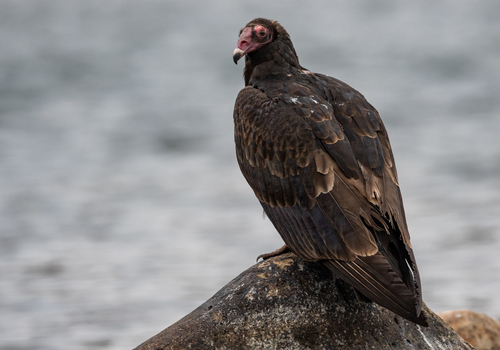
Turkey Vulture
The Turkey Vulture (*Cathartes aura*) is a widespread and distinctive bird of prey found throughout the Americas. Often seen soaring high above open landscapes, it plays a crucial ecological role as a scavenger, efficiently disposing of carrion and thereby helping to prevent the spread of disease. Unlike most birds of prey, it has a highly developed sense of smell, which it uses to locate carcasses. While sometimes perceived negatively due to their diet, Turkey Vultures are essential components of healthy ecosystems. They hold no particular widespread cultural significance, although in some cultures they are viewed as symbols of purification or renewal.
62-81 cm
Length
160-183 cm
Wingspan
Least Concern
Conservation Status
Distribution
The Turkey Vulture has an extensive range, spanning from southern Canada across the entire United States and Mexico, through Central America, and into most of South America, reaching as far south as Tierra del Fuego. They are migratory in the northern parts of their range, with large numbers moving south for the winter. Altitudinal range varies from sea level to high mountain ranges.
Lifespan
Up to 20 years in the wild; longer in captivity.
Turkey Vulture's Habitat
Habitat Types
Open woodlands, Grasslands, Shrublands, Deserts, Agricultural areas, Suburban edges
Climate Zones
Temperate, Tropical, Subtropical, Arid
Adaptations
Turkey Vultures are well-adapted to a variety of habitats, but prefer open areas where thermals, rising columns of warm air, are prevalent, aiding in their soaring flight. Their featherless heads are an adaptation to prevent soiling while feeding inside carcasses.
Variations
Several subspecies are recognized, differing slightly in size and plumage coloration. For example, *Cathartes aura meridionalis* is found in the western United States and is slightly larger than the eastern subspecies, *Cathartes aura septentrionalis*.
Appearance
Breeding Plumage
Plumage is generally consistent throughout the year.
Seasonal Feather Changes
None.
Sex Based Plumage Differences
Males and females have similar plumage.
Notable Features
Featherless, red head (in adults), Dark brown to black body plumage, Pale, ivory-colored bill, Long, broad wings held in a dihedral (V-shape) during soaring, Relatively long tail compared to other vultures
Diet and Feeding
Primary Foods
Carrion (dead animals)
Foraging Behavior
Turkey Vultures primarily locate food by soaring high above the ground, using their keen sense of smell and excellent eyesight. They often gather in groups at large carcasses. They prefer freshly dead animals but will consume more decomposed remains if necessary.
Specializations
Their exceptional sense of smell, unusual among birds, allows them to detect the gases produced by decaying flesh, even under forest canopy. Their strong stomach acid and immune system allow them to safely consume carrion that may be infected with harmful bacteria.
Seasonal Diet Variations
Dietary variations are primarily driven by the availability of carrion, which can fluctuate with seasons and animal mortality patterns. In some areas, roadkill may become a more significant food source during certain times of year.
Behavior
Social Structure
Turkey Vultures are often seen soaring alone or in small groups. They are highly gregarious outside of the breeding season, forming large communal roosts, sometimes numbering hundreds of birds.
Communication
Primarily non-vocal, except for hisses and grunts when feeding or threatened, Visual displays, such as wing postures, are used for communication
Migration
Northern populations are migratory, flying south for the winter. Migratory routes can be extensive, with some birds traveling thousands of kilometers. Southern populations may be resident or only partially migratory.
Territorial or Group Behaviors
Turkey Vultures are not strongly territorial, especially outside of the breeding season. They will, however, defend the immediate area around a carcass from other scavengers.
Conservation
Threats
Lead poisoning (from ingesting lead shot in carcasses), Habitat loss, Collisions with vehicles, Persecution (although less common now), Pesticide exposure (indirectly through contaminated prey)
Protection Programs
Migratory Bird Treaty Act (in the United States), Various state and national wildlife protection laws, Public education campaigns to reduce lead use in hunting
Local National Laws
Protected under various national and international laws, including the Migratory Bird Treaty Act in the United States and Canada.
Population Trend
Stable
Population Estimates
The global population is estimated to be around 4,500,000 individuals.
Interesting Facts
They can smell carrion from over a mile away.
Their olfactory bulb, the part of the brain responsible for smell, is significantly larger than in most other birds.
They urinate on their legs.
This behavior, called urohydrosis, helps to cool them down in hot weather and may also kill bacteria picked up from carcasses.
They lack a syrinx, the vocal organ of birds.
This is why they are limited to making hissing and grunting sounds.
When threatened, they may regurgitate their stomach contents.
This serves as a defense mechanism, as the foul-smelling vomit can deter predators.
Faqs about Turkey Vulture
Are Turkey Vultures dangerous to humans or pets?
No, Turkey Vultures are not dangerous. They are scavengers and feed almost exclusively on dead animals. They pose no threat to humans or pets.
Why do Turkey Vultures have bald heads?
The featherless head prevents feathers from becoming soiled with blood and other fluids when feeding inside carcasses. It also aids in thermoregulation.
Do Turkey Vultures kill their prey?
No, Turkey Vultures are scavengers and feed almost exclusively on animals that are already dead. They lack the strong talons and powerful beaks needed to kill prey.
Where do Turkey Vultures roost at night?
Turkey Vultures roost in large communal groups, often in trees, on rocks, or on other elevated structures. These roosts can contain dozens or even hundreds of birds.
Copyright @ Nature Style Limited. All Rights Reserved.
 English
English